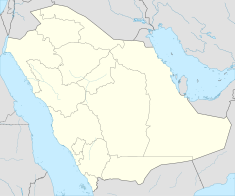Safaniya Field
| Safaniya Oil Field Saudi Arabia | |
|---|---|
| Location of the Safaniya oil field within Saudi Arabia | |
| Country | Saudi Arabia |
| Region | Persian Gulf |
| Offshore/onshore | offshore |
| Coordinates | 28°16′48″N 48°45′0″E / 28.28000°N 48.75000°ECoordinates: 28°16′48″N 48°45′0″E / 28.28000°N 48.75000°E |
| Operator | Saudi Aramco |
| Field history | |
| Discovery | 1951 |
| Start of production | 1957 |
| Production | |
| Current production of oil | 1,200,000 barrels per day (~6.0×107 t/a) |
| Estimated oil in place | 37,000 million barrels (~5.0×109 t) |
| Estimated gas in place | 5,360×109 cu ft (152×109 m3) |
Safaniya Oil Field (Arabic: حقل السفانية النفطي), operated and owned by Saudi Aramco, is the largest offshore oil field in the world. It is located about 265 kilometres (165 mi) north of the company headquarters in Dhahran in the Persian Gulf, Saudi Arabia. Measuring 50 by 15 kilometres (31.1 by 9.3 mi), the field has a producing capability of more than 1.2 million barrels per day (190×103 m3/d).
The oil field was discovered in 1951. It is considered the largest offshore oil field in the world. When it was first put in production in 1957, it flowed 50,000 barrels per day (7,900 m3/d) of crude oil from 18 wells. At the beginning of 1962 it possessed the facilities to handle 350,000 barrels per day (56,000 m3/d) from 25 wells. This sevenfold increase had evolved in just four years and nine months. Its reserve amount to around 37 billion barrels (5.9×109 m3) of oil and 5,360 billion cubic feet (152×109 m3) of natural gas.
The main producing reservoir is the Safaniya which is a cretaceous sandstone in the Wasia formation. Most Geologist believe that the Safaniya field and the neutral Zone Khafji field share the same aquifer that continues toward Kuwaits Burgan field. The Safaniya field has several separate geologic production potential at depths between 4,000 and 7,000 feet. It was brought into production in 1957 at about 25,000 barrels per day. By 1993, there were a total of 624 wells in the field. When Saudi Arabia's oil production peaked in 1980–1981, Safaniya was producing over 1.5 million barrels per day.Today the field still produces 600,000 barrels per day and almost all of Safaniya's oil still comes from the Safaniya formation reservoirs. The Safaniya is also Saudi Arabia's primary supplier of heavy oil at an average API gravity of 27.
The Safaniya Field is the largest offshore oil field in the world and is located in the Persian Gulf. The field is an anticline structure with production area of about 65 km long and 15 km wide. It is a series of structures trending NW-SE caused by uplift movement due to the Zagros reverse fault. Regional tectonic events such as compression occurred along eastern part of the Zagros belt during the Campanian which caused uplift and minor erosion of the Wasia Formation. The eroded units included the Mishrif Member and most of the Rumaila Member. This caused the Aruma unconformity to form. Because of the impact of the regional tectonic events during this time hydrocarbon traps started to form. Burial stage resumed and deposited the Aruma Formation at the end of the Campanian until the end of the Middle Eocene. In between Middle Eocene to Miocene, there was a stop in deposition events due to structural growth and non-deposition in the area. The last major event in the burial history of the area was Plio-Pleistocene Zagros orogeny which resulted in folding with NW-SE trends and uplift in the Persian Gulf area.
...
Wikipedia

